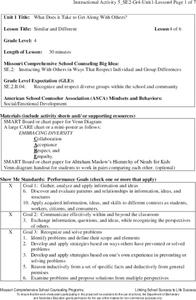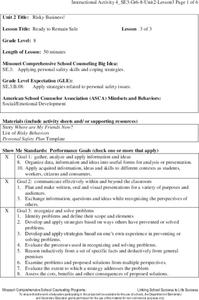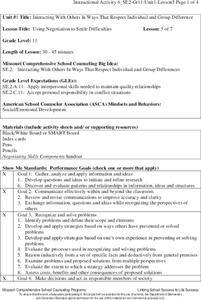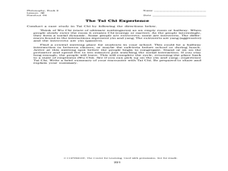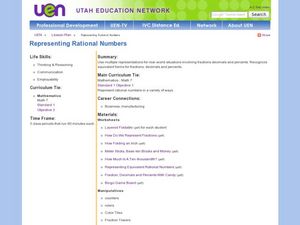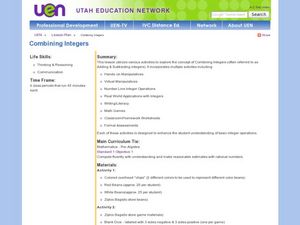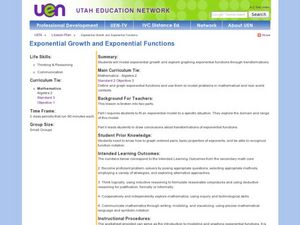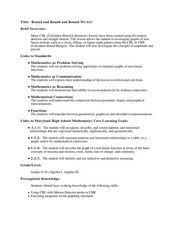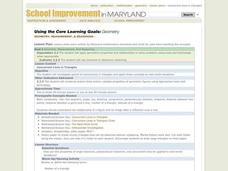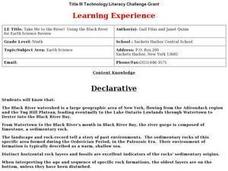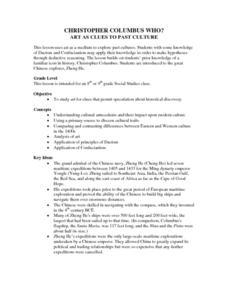Missouri Department of Elementary
Similar and Different
Using a Venn diagram, pupils compare the similarities and differences between two classmates. Next, they review the CARE acronym (Collaboration, Acceptance, Respect, Empathy) and discuss how it applies to diversity in the classroom.
Missouri Department of Elementary
Talk it Over and Work It Out: Compromise!
Stop, Think, Act, Review! Scholars use the STAR method to role play two conflict resolution scenarios about childhood problems such as jealousy or cheating. Then, the larger group judges each case to determine if the compromise is a...
Missouri Department of Elementary
Putting on Armor
Peers can exert tremendous pressure that can lead to positive and negative consequences. To conclude the Risky Business unit, class members create a Personal Safety Plan. They list things or situations that cause stress, things they have...
Missouri Department of Elementary
Life … Bring It On!
To conclude the study of coping skills, class members create a collage that identifies and celebrates their strengths that support their ability to make good decisions.
Missouri Department of Elementary
Managing Conflicts
Conflicts happen. Learning how to manage conflicts in mature and positive ways is an important part of social-emotion growth. The lesson plan offers insight into behaviors that exacerbate conflicts as well as suggestions for how to...
Missouri Department of Elementary
Using Negotiation to Settle Difficulties
Negotiating can be a win/win experience if the involved parties apply the skills and techniques offered in a lesson about negotiating to settle differences.
Missouri Department of Elementary
The Clique
Mean girls and bully packs are favorite topic for films and TV shows that focus on the destructive power of cliques. High school freshmen are asked to reflect on both the positive and negative aspects of cliques by reading a short...
Curated OER
Scientific Revolution
In this online interactive world history instructional activity, students answer 20 matching questions regarding the Scientific Revolution. Students may submit their answers to be scored.
Curated OER
Iterating Linear Functions
Students use a spreadsheet to investigate data. In this algebra lesson, students collect and graph data on a coordinate plane. They explain properties of a linear equation both algebraically and orally.
Curated OER
Conditional Statements
Students are introduced to the topic of proofs in Geometry. During a PowerPoint presentation, they take notes on indirect proofs and have groups of students write a true statement. They are assessed on the statement and how well they...
Curated OER
Tai Chi
Students explore the concept of yin and yang. For this Tai Chi lesson, students create a working definition of yin and yang as they read about its role in Eastern philosophy. Students also discuss the relationship between opposites.
Curated OER
Representing Rational Numbers
Seventh graders explore rational numbers. In this fractions, decimals, and percents lesson plan, 7th graders identify and compare equivalencies between fractions, decimals, and percents. Students use hands-on activities to investigate...
Curated OER
Combining Integers
Seventh graders explore the concept of adding and subtracting integers. In this adding and subtracting integers instructional activity, 7th graders use white and red beans to demonstrate adding and subtracting integers. Students play an...
Curated OER
Exponential Growth and Exponential Functions
Students explore the concept of exponential functions. In this exponential functions lesson, students model exponential growth about a high school population using an applet. Students manipulate the applet to show the effect that a...
Curated OER
Iterating the Function over Real Numbers
Students use a spreadsheet to find sequences of numbers. In this algebra lesson, students find the values for c of a quadratic written in standard form. They relate the behavior of the graph to the values of the equation.
Curated OER
Iterating the Function and Complex Numbers
Students identify the end behavior of polynomial graphs. In this algebra lesson, students factor and solve quadratic and complex equations. They factor out negative roots and identify the real and imaginary parts of an equation.
Curated OER
Round and Round and Round We Go!
Students investigate motion using a CBL. In this algebra lesson plan, students collect and graph data on a coordinate plane. They define and identify amplitude and period of conic graphs.
Curated OER
Concurrent Lines in Triangles
Students explore the concept of concurrent lines in triangles. In this concurrent lines in triangles lesson, students work in groups to investigate properties of concurrent lines in acute, right, and obtuse triangles. Students use a...
Curated OER
Electric Circuits
Students model the flow of electrons in a circuit, draw diagrams of an electric circuit and build an electric circuit. Students explain how to tell when the path of an electric circuit is complete, and test the conductivity of a variety...
Curated OER
The Hijacker - How a Virus Spreads
Students view a video that presents how viruses attack the body and how the body's immune system responds. They simulate the spread of an infectious disease and establish the identity of the original carrier.
Curated OER
Human Traces
Students create and construct human skeletons by rubbing casts of bone impressions on paper, and then label most important components of human skeleton.
Curated OER
Take Me to the River! Using the Black River for Earth Science Review
Ninth graders use maps to identify landscape regions and drainage patterns producing the Black River. They create PowerPoint presentations pertaining to the Black River watershed, its geologic history and highlighting safe rafting...
Curated OER
Christopher Columbus Who?
Young scholars recreate a "60-minutes" interview using cue cards and historical information on the Chinese explorer Zheng He. This lesson is an excellent introduction to World History during the 1400's.
Curated OER
Particulate Observation Lab
Learners collect samples of common dust from their homes and school for examination under a microscope. They identify the components of their samples using the provided "Atlas of Indoor Dust Particles." Pupils take samples form a variety...
Other popular searches
- Deductive Reasoning Puzzles
- Deductive Reasoning Math
- Deductive Reasoning Problems
- Geometry Deductive Reasoning
- Deductive Reasoning Essay
- Deductive Reasoning Pictures
- Health Deductive Reasoning
- Inductive Deductive Reasoning
- Decimals Deductive Reasoning


